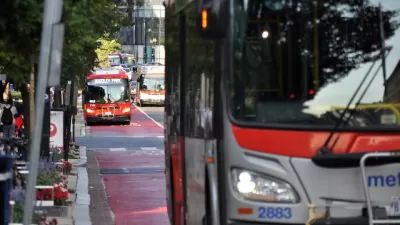After decades of big, expensive plans, diverting cars from a busy streetcar route will make a bigger difference to commuters for far less money.

One of Canada’s largest newspapers is urging transportation planners to stop thinking big.
From The Globe and Mail:
“In Canada's megalopolis, there is always some hulk of exceedingly expensive, allegedly transformational transit being pondered, pedalled or dreamt on. The problem is that these either never get built – or worse, they get built.”
Instead, the paper’s editorial board praises a one-year pilot project just put into place that “severely” restricts cars from a stretch of King Street that is also home to Toronto’s “busiest streetcar route.”
"The cost of this big change on one of the busiest transit routes in the city? Small. Instead of being measured in billions of dollars and decades of construction, it involved the exorbitant expense of trucking in a few concrete barriers, changing a handful of road signs and buying some yellow paint. Construction period? Counted in days. This in a city used to endlessly debating big, transformative transit solutions that, if they could get funded, would arrive around the time one of Jagmeet Singh's grandchildren is elected prime minister."
But there is one problem—unlike the big, expensive projects that aren’t getting built and don’t serve as many passengers, for this project, the “branding is all wrong.”
"Without big brand ambition, politicians won't be able to love the little miracle on King Street. So, first item of business? Stop calling it TTC route No. 504. Heck, stop calling it a streetcar. Rename it the Cross-Town Rapid Transit Way. The Super Fast Surface Service. The Toronto Hyperloop. The King Street Subway. Whatever."
So, the paper writes, even if the projects is small, please “[m]ake no little marketing plans.”
FULL STORY: Globe editorial: A little transit miracle grows on King Street

Alabama: Trump Terminates Settlements for Black Communities Harmed By Raw Sewage
Trump deemed the landmark civil rights agreement “illegal DEI and environmental justice policy.”

Planetizen Federal Action Tracker
A weekly monitor of how Trump’s orders and actions are impacting planners and planning in America.

The 120 Year Old Tiny Home Villages That Sheltered San Francisco’s Earthquake Refugees
More than a century ago, San Francisco mobilized to house thousands of residents displaced by the 1906 earthquake. Could their strategy offer a model for the present?

In Both Crashes and Crime, Public Transportation is Far Safer than Driving
Contrary to popular assumptions, public transportation has far lower crash and crime rates than automobile travel. For safer communities, improve and encourage transit travel.

Report: Zoning Reforms Should Complement Nashville’s Ambitious Transit Plan
Without reform, restrictive zoning codes will limit the impact of the city’s planned transit expansion and could exclude some of the residents who depend on transit the most.

Judge Orders Release of Frozen IRA, IIJA Funding
The decision is a victory for environmental groups who charged that freezing funds for critical infrastructure and disaster response programs caused “real and irreparable harm” to communities.
Urban Design for Planners 1: Software Tools
This six-course series explores essential urban design concepts using open source software and equips planners with the tools they need to participate fully in the urban design process.
Planning for Universal Design
Learn the tools for implementing Universal Design in planning regulations.
Clanton & Associates, Inc.
Jessamine County Fiscal Court
Institute for Housing and Urban Development Studies (IHS)
City of Grandview
Harvard GSD Executive Education
Toledo-Lucas County Plan Commissions
Salt Lake City
NYU Wagner Graduate School of Public Service





























